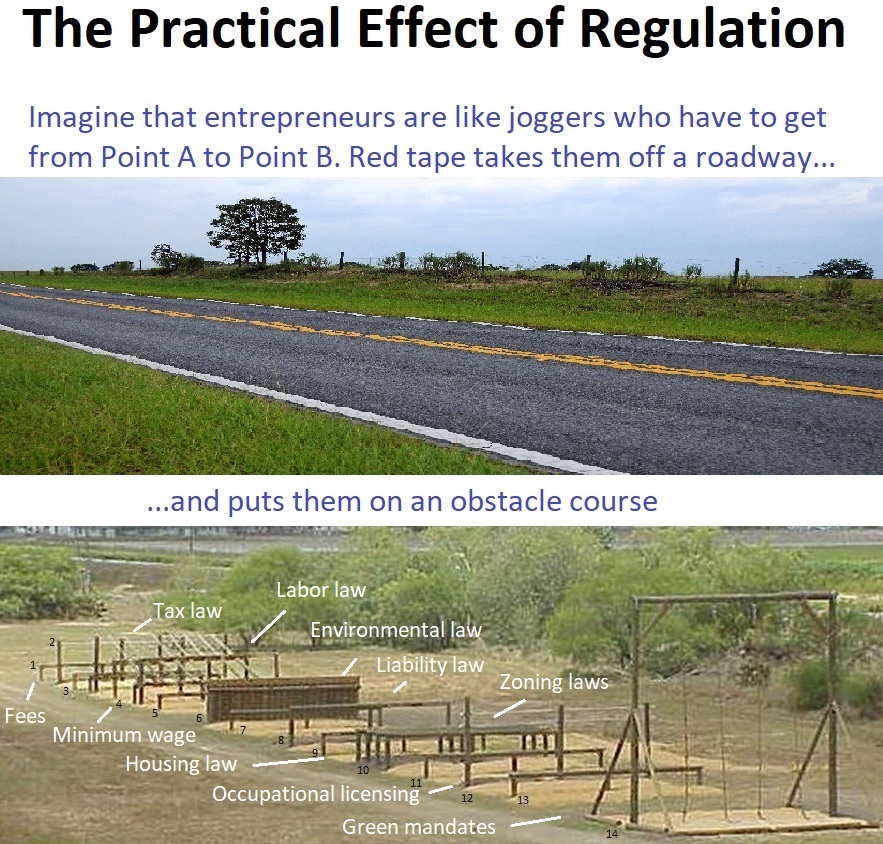I’ve shared Kite & Key videos about Social Security, comparative economics, free trade, the national debt, patriotism, and free markets.
Here’s their video on the under-appreciated problem of permitting and red tape.
This video is tangible evidence for my proposition that red tape is akin to an obstacle course.
Not only does regulation make everything more expensive, it also means it takes much longer to go from Point A to Point B.
Or, in the examples cited in the video, to go from planning something to building something.
I’ve written about some of those examples, including the infamous 2nd Avenue Subway and California’s high-speed rail boondoggle.
These wasteful projects are great for insiders, who rack up massive fees, but they are very bad news for taxpayers and the economy.
Fortunately, we may get some relief from the Trump Administration, as reported in the Hill last month by Rachel Frazin and Zack Budryk. Here are some excerpts.
The Trump administration has tossed decades of environmental policy — laying the groundwork for an overhaul of how the federal government implements a bedrock environmental law. …the National Environmental Policy Act (NEPA)…requires the federal government to consider the environmental consequences before approving infrastructure projects ranging from roads and bridges to oil and gas pipelines to solar farms. …for decades, the federal government has relied on White House and agency regulations to spell out how to go about doing those environmental assessments. This week, the Trump administration rescinded all White House regulations directing the implementation of the law, including some that go back to 1978. …Under the Trump administration, agencies are likely to take an approach that maximizes the speed of approving new projects and minimizes environmental considerations.
Kudos to Trump.
He was fairly good on regulation in his first term and it’s good to see him being aggressive to start his second term.
That being said, the federal government is not the only problem.
A story from last month by Rachel Siegel in the Washington Post reveals how red tape is creating a second tragedy for victims of wildfires.
Here are some relevant passages about some unfortunate residents in Hawaii.
Construction crews have hauled away toxic debris, but entire neighborhoods still sit empty. Only six homes have been rebuilt in the county. Much of the town sits in the purgatory… But the months since have given way to a different kind of crisis — of grinding bureaucracy, soaring housing costs and growing frustration. It’s also a forecast, experts say, for what is likely ahead in Los Angeles… residents still say they are stuck in the slog. Permits — a crucial step to constructing a house or business — take months or longer to come through. Only a handful of people have finished rebuilding, and many others aren’t sure if they can as they navigate a dizzying maze of zoning and construction rules. …“We’re at the point now where we should have been a year ago,” said Warren Freeland, whose family lost the historic Pioneer Inn in Lahaina’s wildfires. …After a wildfire, there’s often a life cycle to recovery. That starts with an immediate emergency response… Full recovery can take five years or more… The permitting process has become a major roadblock for people eager to rebuild homes and businesses. The process can cost hundreds of thousands of dollars…A few local and state rules might smooth the process. One bill would let people rebuild properties that don’t conform to current codes but were legal when they were first built.
As you might suspect, the same problem exists in Los Angeles.
There are signs of a similar crisis in Los Angeles County… Immediately after the disaster, Gov. Gavin Newsom (D) promised to “cut red tape,” including by waiving certain regulatory and environmental laws so Los Angeles fire victims could rebuild faster.
Since Newsom wants to run for president, he has an incentive to show positive results, so maybe he’ll do something good.
Based on his track record, we can be skeptical. But political ambition often trumps ideology (as explained by “public choice“), so there’s some hope.
P.S. Here’s some evidence about the negative overall impact of red tape.




